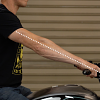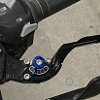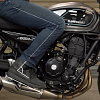Well, that’s exactly what some people do with their motorcycles: They buy the bike and, other than tweaking the mirrors, they ride it as-is, unaware of the quick and easy adjustments that can be made to improve comfort as well as provide better, more intuitive control of the bike. Every motorcycle can and should be adapted to suit your height and riding style, and best of all, it’s free.
The best place to start is with the angle of the handlebar levers, since that has such a big impact on comfort and control. I see a lot of people riding with what I’d call flat clutch and brake levers; they’re angled too high so you have to tilt your fingers up to reach the levers, and that causes wrist pain and reduces your pulling power.
To determine the ideal angles for you, sit in your normal riding position and rest your index and middle finger on top of the levers. You should be able to draw a straight line from your elbows to your fingertips. If that’s not the case, loosen the lever perches and rotate the levers up, or more likely, down, to the appropriate angle for you.

Having the proper lever angle makes it easier and more comfortable to reach and operate the controls. That’s especially important for the brake, which you should be covering with one or more fingers at all times so you’re ready to slow down in an instant.
Next up is lever reach, which is largely determined by hand size, but also personal preference. For example, Zack and I wear the same size gloves, but I like the brake lever close to the grip while Zack likes it farther out.
Sometimes, the brake or both levers will offer a dial or threaded adjuster so you can move the lever in or out. If not, you can still manipulate the clutch engagement point by adjusting the cable slack (just make sure the clutch still disengages fully when the lever is in, and there’s adequate free play when it’s out), or you can shift the entire lever assemblies left or right on the handlebar to change where your fingers fall on the lever. You might get better feel if your fingers rest right in the bend, or you can get more leverage and lever stroke if you pull closer to the end of the lever.

If your bike’s levers aren’t adjustable or you can’t attain a comfortable reach with the existing range, then it might be worth investing in a set of aftermarket levers. Besides providing loads of lever positions, aftermarket levers often have ball-bearing pivots and other quality features.
The last bit of easy adjustment up in the cockpit is with the handlebar or clip-on position. Consider rotating your handlebar forward if you feel like the grips are in your lap, or rotate them back if they’re too far away. A good default is in line with the fork legs, but that’s not a rule, so feel free to experiment to see what works best for you. Keep in mind you’ll likely need to readjust your lever and mirror angles after rotating the handlebar.
For sport bikes with clip-ons, you can often swing the clip-ons in or out to better match your arm length and shoulder width, but you’ll want to make sure the bar end doesn’t hit the tank or windscreen at full lock.

Then, there are your foot controls, namely the rear brake lever height and shifter height. Where they should be positioned is determined by foot size, leg length, and corresponding ankle angle, as well as personal preference.
For the best comfort and quickest application, your rear brake lever should be right below the ball of your foot. To change the height, loosen the locknut and rotate the pushrod. When you’re done, make sure the rear brake light still activates properly, and adjust it if needed.
Finally, there’s shifter height. If it’s in the right position, you should be able to make an upshift or downshift with minimal ankle movement. To change where the tab is you can either loosen the locknuts and spin the rod in or out, or you can rotate the entire lever on the splines. For linkage systems, it’s important to maintain close to a 90-degree angle between assemblies for maximum leverage and throw, so you may have to juggle rod length and spline position to find the right setup.

The difference between a bike feeling right versus feeling awkward could be something as simple as the brake angle and shifter height, so take a few minutes to adjust your levers and foot controls so your motorcycle is set up for you. You’re going to be more comfortable, so you can ride longer, and you’re going to be more confident, since your bike will be easier and more instinctive to control.









